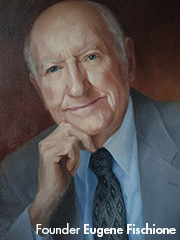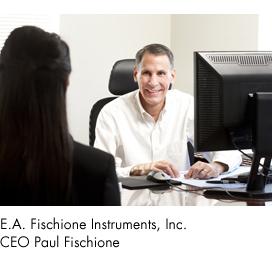Mission
To ensure a customer focus, while providing the highest quality, most innovative instrumentation to the microscopy community.Fischione will continue to serve existing needs, as well as address the requirements of emerging microscopy and nanotechnology applications.
History
1966年
 Eugene A. Fischione founded E.A. Fischione Instruments, Inc. in 1966. As a research machinist at the U.S. Steel Technical Center (formerly U.S. Steel Research Center) from 1956 to 1977, Eugene Fischione was involved with many of the early developments in electron microscopy. His contributions were concentrated in the area of developing and fabricating experimental instrumentation.
Eugene A. Fischione founded E.A. Fischione Instruments, Inc. in 1966. As a research machinist at the U.S. Steel Technical Center (formerly U.S. Steel Research Center) from 1956 to 1977, Eugene Fischione was involved with many of the early developments in electron microscopy. His contributions were concentrated in the area of developing and fabricating experimental instrumentation.
As technology advanced, the need increased to develop products that prepare the specimen for observation and analysis in the electron microscope (EM). Working with leading materials scientists, Eugene Fischione developed the118bet金博宝app . From a thin foil, this device prepares a specimen acceptable for direct observation in a transmission electron microscope.(1) This instrument is still being sold and can be found in laboratories in more than 40 countries.
1978-1994
After graduation as a mechanical engineer from the University of Pittsburgh in 1978, Paul E. Fischione, son of the founder, gained experience in the research and engineering departments at Mine Safety Appliances Company (MSA) and United Technologies Corporation (UTC). After acquiring ownership of the company in 1986, Paul Fischione established its future direction and initiated new product developments, including:
- Electropolisher ancillary products
- Specimen preparation instrumentsto meet the changing focus of electron microscopy for the study of advanced materials research specimens (i.e., ceramics, semiconductors, high-Tc superconductors, and metal matrix composites) for transmission electron microscopy (TEM)
- 专业标本夹技术for the presentation of the specimen to the electron optics
- Ultra-high resolution imaging detector
The Fischione Instruments product line was expanded to include all of the major devices that are required for preparing TEM specimens:
- TheModel 170 Ultrasonic Disk Cutter
- The118bet网娱乐
- The Model 1010 Ion Mill (replaced by the Model 1050 TEM Mill in 2010 and then theModel 1051 TEM Millin 2016)
1995-Present
In 1995, a new era of specimen preparation was created with the introduction of theModel 1020 Plasma Cleaner. The Model 1020 uses a low-energy gas plasma to remove organic contamination from TEM specimens. The patented technology of the Model 1020 is critical when conducting electron microscopy using state-of-the-art TEMs. The introduction of the Model 1020 marked the first time that Fischione Instruments initiated a technology into the marketplace, greatly enhancing its reputation as a premier supplier of advanced TEM related instrumentation.
Introduced in 1998, the型号3000环形暗场检测器provides high-resolution scanning/transmission electron microscopy (STEM) imaging. Seeing the move in microscopy from two-dimensional to three-dimensional information, in 2002 Fischione Instruments introduced theModel 2020 Advanced Tomography Holder. The Model 2020 allows room temperature data collection over wide tilt and translation ranges, even in TEMs with restrictive pole piece gap geometries. The tomography holder product line has been subsequently expanded to include theModel 2030 Ultra-Narrow Gap Tomography Holder(2005), theModel 2040 Dual-Axis Tomography Holder(2006), and theModel 2050 On-Axis Rotation Tomography Holder(2006).
Because Fischione Instrument’s business is to provide tools for advanced forms of specimen preparation for TEM, it recognized that many TEM preparation techniques have become applicable to SEM samples. As a result, in 2003 Fischione Instruments introduced the Model 1030 Automated Sample Prep (ASaP) System. The Model 1030 ASaP combines the features of plasma cleaning, ion beam etching, reactive ion etching, and high-resolution ion beam sputter coating.
In keeping with its tradition of innovation in advanced specimen preparation technology, and considering the increased usage of focused ion beam (FIB) systems for the preparation of specimens from specific sites within the bulk material, Fischione developed technology to enhance the quality of both conventional and FIB-prepared specimens. This yielded the1188金宝搏亚洲 , which was introduced in 2004. The NanoMill system features ion energies as low as 50 eV and a beam size as small as 1 µm.
To take specimen preparation to the next level, Fischione Instruments launched three major new products in 2010. The Model 1050 TEM Mill (since replaced by theModel 1051 TEM Millin 2016) was a conventional ion milling system used for creating the thin, electron transparent specimens needed for TEM imaging and analysis. Applying TEM ion beam milling technology to scanning electron microscopy (SEM) samples yielded the Model 1060 SEM Mill, which was updated to theModel 1061 SEM Millin 2016. Leveraging much of the product technology contained in the TEM Mill, the SEM Mill serves a broad range of applications including semiconductors, enhancing surfaces for electron backscatter detection (EBSD), as well as the rapidly expanding field of large-scale imaging of geological samples.
Building upon the outstanding tradition of the Model 1020 Plasma Cleaner, theModel 1070 NanoCleanwas introduced. The Model 1070 uses plasma technology to automatically and quickly remove organic contamination (hydrocarbon) from electron microscopy specimens, specimen holders, and stubs.
The year 2014 proved to be an important year for Fischione Instruments. Two new ion milling instruments were introduced: the118bet网址多少 and theModel 1063 WaferMill™ ion beam delayering solution.
PicoMill系统构建的成功之上Model 1040 NanoMill system. In addition to providing ultimate specimen quality that is free from amorphous and implanted layers, the PicoMill system includes in situ imaging through the addition of a scanning electron column, as well as a backscatter electron detector (BSE), a secondary electron detector (SED) and a STEM detector. The STEM capability is especially notable because that feature enables the PicoMill system to perform endpoint detection.
The WaferMill solution for CD-SEM sample preparation provides selected-area milling on full 300 mm wafers, which allows the delayering of multiple pre-selected regions on a full wafer from the top down. The entire process is automated; there is no need to manually touch a wafer.
The addition of the PicoMill system and the WaferMill solution mark Fischione's significant investment in developing products for the semiconductor market segment.
Other products introduced that year includes a motorized version of the Model 2040 Dual-Axis Tomography Holder — theModel 2045 Motorized Dual-Axis Tomography Holder. In addition, Fischione introduced theModel 2560 Vacuum Transfer Tomography Holder, which is intended for sensitive specimens that can be altered by environmental conditions; the specimen can be transferred in the presence of vacuum or an inert gas environment.
Fischione also signaled its commitment to the life sciences market segment with the introduction of theModel 2550 Cryo Transfer Tomography Holder, which is ideal for specimens that require liquid-nitrogen cooling for transfer to the TEM for imaging and analysis.
如今,Fisc188bet体育国际hione Instrum188bet金宝搏体育ents的产品在全球500多个研究实验室中被发现。最终用户是在大学,半导体制造商,核和医疗材料研究公司,钢铁,汽车,航空航天和通信公司工作的显微镜,材料科学家,冶金学家和生活科学家,以及美国国防部的分支机构和几个国家实验室。188bet金宝搏体育产品直接在美国和外国配送网络中销售。
NanoMill and PicoMill are registered trademarks of E.A. Fischione Instruments, Inc. WaferMill is a trademark of E.A. Fischione Instruments, Inc.

